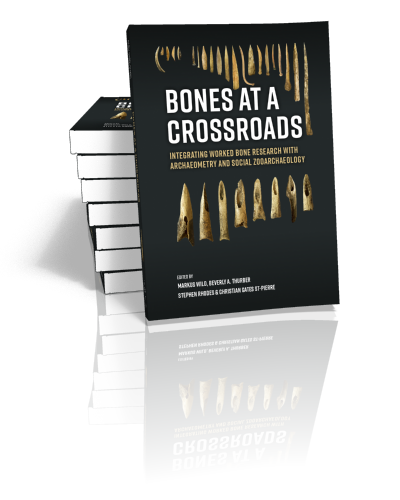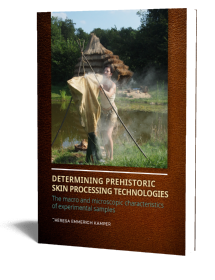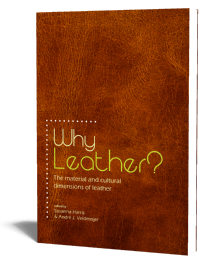Bones at a crossroads
Integrating Worked Bone Research with Archaeometry and Social Zooarchaeology
Edited by Markus Wild, Beverly A. Thurber, Stephen Rhodes & Christian Gates St-Pierre | 2021

Bones at a crossroads
Integrating Worked Bone Research with Archaeometry and Social Zooarchaeology
Edited by Markus Wild, Beverly A. Thurber, Stephen Rhodes & Christian Gates St-Pierre | 2021
Paperback ISBN: 9789464270068 | Hardback ISBN: 9789464270075 | Imprint: Sidestone Press Academics | Format: 182x257mm | 317 pp. | Language: English | 44 illus. (bw) | 48 illus. (fc) | Keywords: archaeology; worked bone; zooarchaeology; technology; integrative approach; material culture | download cover
Read online or downloaded 1989 times
-
Digital & Online access
This is a full Open Access publication, click below to buy in print, browse, or download for free.
-
Buy via Sidestone (EU & UK)
-
Buy via our Distributors (WORLD)
For non-EU or UK destinations you can buy our books via our international distributors. Although prices may vary this will ensure speedy delivery and reduction in shipping costs or import tax. But you can also order with us directly via the module above.
UK international distributor
USA international distributor
-
Bookinfo
Paperback ISBN: 9789464270068 | Hardback ISBN: 9789464270075 | Imprint: Sidestone Press Academics | Format: 182x257mm | 317 pp. | Language: English | 44 illus. (bw) | 48 illus. (fc) | Keywords: archaeology; worked bone; zooarchaeology; technology; integrative approach; material culture | download cover
Read online or downloaded 1989 times

We will plant a tree for each order containing a paperback or hardback book via OneTreePlanted.org.
Bone tool studies are at a crossroads. A current path is to go beyond the concatenation of methods or concepts borrowed from other disciplines and aim instead at a truly integrated approach that is more in line with the objectives of interdisciplinary and transdisciplinary research.
The papers in this volume follow this direction by adopting various forms of dialogue and integration between old and new methods and approaches, including technological analysis, usewear analysis, typology, zooarchaeology, stable isotope analysis, experimental archaeology or spatial analysis. They represent a mixture of methodological issues, case studies, and discussions of larger cultural and historical phenomena that span thousands of years and many parts of the World, from South Asia to the Near East and Europe, and from North to South America. The synergies deriving from these multi-perspective approaches lead to the repeated identification of diverse social aspects of past societies, including the identification of general social contexts of bone tool production and use, transmission of knowledge, the symbolic dimensions of artifacts, and intergroup relations as well as warfare and state formation processes.
All these papers grew out of communications presented at the 13th meeting of the Worked Bone Research Group (WBRG) on October 7th–13th, 2019, at the Département d’anthropologie, Université de Montréal, Canada. The WBRG is an official working group of the International Council for Archaeozoology (ICAZ) dealing with the study of worked faunal remains from archaeological sites.
Introduction
Christian Gates St-Pierre, Markus Wild, Beverly A. Thurber, Stephen E. Rhodes
Osseous arrowheads in the Iron Age of the Upper Ganga Plains
Vinayak
Uncovering some aspects of the worked bone assemblages from Periods I-III (Neolithic to Pre-Northern Black Polished Ware with Iron Cultures) of Agiabir, India
Ravi Shankar, Pramod P. Joglekar, Sharada Channarayapatna, and Ashok Kumar Singh
Magnifying the differences: Investigating variability in Dorset Paleo-Inuit organic material culture using microscopic analysis
Matilda I. Siebrecht, Sean P. A. Desjardins, Sarah M. Hazell, Susan Lofthouse, Elsa Cencig, Katie Kotar, Peter D. Jordan, and Annelou van Gijn
Antler as raw material among hunter-gatherer groups from the Pampean Region (Argentina)
Natacha Buc, Alejandro A. Acosta, and Lucía T. Rombolá
Osseous artifacts from the Maros-culture necropolis at Ostojićevo (northern Serbia)
Selena Vitezović
An antler workshop in a Germanic settlement in Nitra, Slovakia
Gertrúda Březinová and Erik Hrnčiarik
The worked bone and tooth assemblage from Piaçaguera: Insights and challenges
Daniela Klokler
Traceological evaluation of bone instruments as an indirect indicator: Rebuilding textile technology during the Ceramic period on Mocha Island (Chile)
Helga Inostroza Rojas
A microscopic view of Maya needle and perforator production at Ucanal, Guatemala
Carolyn Freiwald, Christina Halperin, Camille Dubois-Francoeur, Caroline Schlinsog, and Kimberly A. Bauer
Warm it up! Using experimental archaeology to test shark teeth extraction hypotheses
Simon-Pierre Gilson and Andrea Lessa
Crafting white-tailed deer (Odocoileus virginianus) bone and antler at Cerro Juan Díaz (LS-3), Greater Coclé Culture Area, Panama
María Fernanda Martínez-Polanco, Luis Alberto Sánchez-Herrera, Máximo Jiménez-Acosta, and Richard G. Cooke
Preliminary spatial analysis of the morphologically identifiable bone tools from an Early Bronze Age III domestic building in a residential neighborhood house at Tell eṣ-Ṣâfi/Gath (Stratum E5c)
Sarah J. Richardson, Haskel J. Greenfield, Tina L. Greenfield, and Aren M. Maeir
A Woodland-period bone tool industry on the northern Gulf of Mexico coastal plain
Gregory A. Waselkov, Sarah E. Price, Alexandra Stenson, Carla S. Hadden, and Long Dinh
The many dimensions of a bone
Marie-Ève Boisvert, Claire St-Germain, and Christian Gates St-Pierre

Dr. Markus Wild
Markus Wild studied in France and Germany and works as postdoctoral research fellow at the Centre for Baltic and Scandinavian Archaeology, Germany. His research projects try to elucidate human behavioural evolution and particularly focus on the material culture and chronology of the Upper Palaeolithic to Mesolithic in northwestern Europe. He has developed expertise in technological analysis and radiocarbon dating of worked bone. His research interests also include risk management in hunter-gatherer societies, children’s learning, and interdisciplinary approaches to archaeology.

Dr. Beverly A. Thurber
Beverly A. Thurber is an independent scholar based in the Chicago area whose main research interest is early ice skating, especially bone skates. She has four degrees in four different things, including a PhD from Cornell University, and has studied in the US, the UK, and Germany. From 2009 to 2017, she taught a variety of courses in mathematics, science, and the humanities at Shimer College. Her book Skates Made of Bone: A History was published in 2020.

Stephen Rhodes MSc
Stephen Rhodes is a zooarchaeologist interested in the shift from hunting to herding in the Neolithic of Southwest Asia. He has worked in Syria, Lebanon, and Jordan, and since 2017 is involved in an ongoing project in Kvemo Kartli, Georgia. The large numbers of bone tools recovered from the excavations in Georgia have led him to incorporate these objects, and the perishable technologies they represent, into his analysis of Neolithic subsistence change. He is currently a Doctoral Candidate in the Department of Anthropology at the University of Toronto.

Dr. Christian Gates St-Pierre
Christian Gates St-Pierre is Assistant Professor at the Université de Montréal, Canada. His research projects are focusing on the subsistence and material culture of Pre-Contact Iroquoian societies in Northeastern North America. He has developed an expertise in the technological and functional analysis of worked bone, including microwear analysis. His research interests also include social archaeology, ethical issues, and the politics of archaeological heritage.
Abstract:
Bone tool studies are at a crossroads. A current path is to go beyond the concatenation of methods or concepts borrowed from other disciplines and aim instead at a truly integrated approach that is more in line with the objectives of interdisciplinary and transdisciplinary research.
The papers in this volume follow this direction by adopting various forms of dialogue and integration between old and new methods and approaches, including technological analysis, usewear analysis, typology, zooarchaeology, stable isotope analysis, experimental archaeology or spatial analysis. They represent a mixture of methodological issues, case studies, and discussions of larger cultural and historical phenomena that span thousands of years and many parts of the World, from South Asia to the Near East and Europe, and from North to South America. The synergies deriving from these multi-perspective approaches lead to the repeated identification of diverse social aspects of past societies, including the identification of general social contexts of bone tool production and use, transmission of knowledge, the symbolic dimensions of artifacts, and intergroup relations as well as warfare and state formation processes.
All these papers grew out of communications presented at the 13th meeting of the Worked Bone Research Group (WBRG) on October 7th–13th, 2019, at the Département d’anthropologie, Université de Montréal, Canada. The WBRG is an official working group of the International Council for Archaeozoology (ICAZ) dealing with the study of worked faunal remains from archaeological sites.
Contents
Introduction
Christian Gates St-Pierre, Markus Wild, Beverly A. Thurber, Stephen E. Rhodes
Osseous arrowheads in the Iron Age of the Upper Ganga Plains
Vinayak
Uncovering some aspects of the worked bone assemblages from Periods I-III (Neolithic to Pre-Northern Black Polished Ware with Iron Cultures) of Agiabir, India
Ravi Shankar, Pramod P. Joglekar, Sharada Channarayapatna, and Ashok Kumar Singh
Magnifying the differences: Investigating variability in Dorset Paleo-Inuit organic material culture using microscopic analysis
Matilda I. Siebrecht, Sean P. A. Desjardins, Sarah M. Hazell, Susan Lofthouse, Elsa Cencig, Katie Kotar, Peter D. Jordan, and Annelou van Gijn
Antler as raw material among hunter-gatherer groups from the Pampean Region (Argentina)
Natacha Buc, Alejandro A. Acosta, and Lucía T. Rombolá
Osseous artifacts from the Maros-culture necropolis at Ostojićevo (northern Serbia)
Selena Vitezović
An antler workshop in a Germanic settlement in Nitra, Slovakia
Gertrúda Březinová and Erik Hrnčiarik
The worked bone and tooth assemblage from Piaçaguera: Insights and challenges
Daniela Klokler
Traceological evaluation of bone instruments as an indirect indicator: Rebuilding textile technology during the Ceramic period on Mocha Island (Chile)
Helga Inostroza Rojas
A microscopic view of Maya needle and perforator production at Ucanal, Guatemala
Carolyn Freiwald, Christina Halperin, Camille Dubois-Francoeur, Caroline Schlinsog, and Kimberly A. Bauer
Warm it up! Using experimental archaeology to test shark teeth extraction hypotheses
Simon-Pierre Gilson and Andrea Lessa
Crafting white-tailed deer (Odocoileus virginianus) bone and antler at Cerro Juan Díaz (LS-3), Greater Coclé Culture Area, Panama
María Fernanda Martínez-Polanco, Luis Alberto Sánchez-Herrera, Máximo Jiménez-Acosta, and Richard G. Cooke
Preliminary spatial analysis of the morphologically identifiable bone tools from an Early Bronze Age III domestic building in a residential neighborhood house at Tell eṣ-Ṣâfi/Gath (Stratum E5c)
Sarah J. Richardson, Haskel J. Greenfield, Tina L. Greenfield, and Aren M. Maeir
A Woodland-period bone tool industry on the northern Gulf of Mexico coastal plain
Gregory A. Waselkov, Sarah E. Price, Alexandra Stenson, Carla S. Hadden, and Long Dinh
The many dimensions of a bone
Marie-Ève Boisvert, Claire St-Germain, and Christian Gates St-Pierre

Dr. Markus Wild
Markus Wild studied in France and Germany and works as postdoctoral research fellow at the Centre for Baltic and Scandinavian Archaeology, Germany. His research projects try to elucidate human behavioural evolution and particularly focus on the material culture and chronology of the Upper Palaeolithic to Mesolithic in northwestern Europe. He has developed expertise in technological analysis and radiocarbon dating of worked bone. His research interests also include risk management in hunter-gatherer societies, children’s learning, and interdisciplinary approaches to archaeology.

Dr. Beverly A. Thurber
Beverly A. Thurber is an independent scholar based in the Chicago area whose main research interest is early ice skating, especially bone skates. She has four degrees in four different things, including a PhD from Cornell University, and has studied in the US, the UK, and Germany. From 2009 to 2017, she taught a variety of courses in mathematics, science, and the humanities at Shimer College. Her book Skates Made of Bone: A History was published in 2020.

Stephen Rhodes MSc
Stephen Rhodes is a zooarchaeologist interested in the shift from hunting to herding in the Neolithic of Southwest Asia. He has worked in Syria, Lebanon, and Jordan, and since 2017 is involved in an ongoing project in Kvemo Kartli, Georgia. The large numbers of bone tools recovered from the excavations in Georgia have led him to incorporate these objects, and the perishable technologies they represent, into his analysis of Neolithic subsistence change. He is currently a Doctoral Candidate in the Department of Anthropology at the University of Toronto.

Dr. Christian Gates St-Pierre
Christian Gates St-Pierre is Assistant Professor at the Université de Montréal, Canada. His research projects are focusing on the subsistence and material culture of Pre-Contact Iroquoian societies in Northeastern North America. He has developed an expertise in the technological and functional analysis of worked bone, including microwear analysis. His research interests also include social archaeology, ethical issues, and the politics of archaeological heritage.
-
Digital & Online access
This is a full Open Access publication, click below to buy in print, browse, or download for free.
-
Buy via Sidestone (EU & UK)
-
Buy via our Distributors (WORLD)
For non-EU or UK destinations you can buy our books via our international distributors. Although prices may vary this will ensure speedy delivery and reduction in shipping costs or import tax. But you can also order with us directly via the module above.
UK international distributor
USA international distributor
- Browse all books by subject
-
Search all books

We will plant a tree for each order containing a paperback or hardback book via OneTreePlanted.org.
You might also like:
© 2025 Sidestone Press KvK nr. 28114891 Privacy policy Sidestone Newsletter Terms and Conditions (Dutch)








